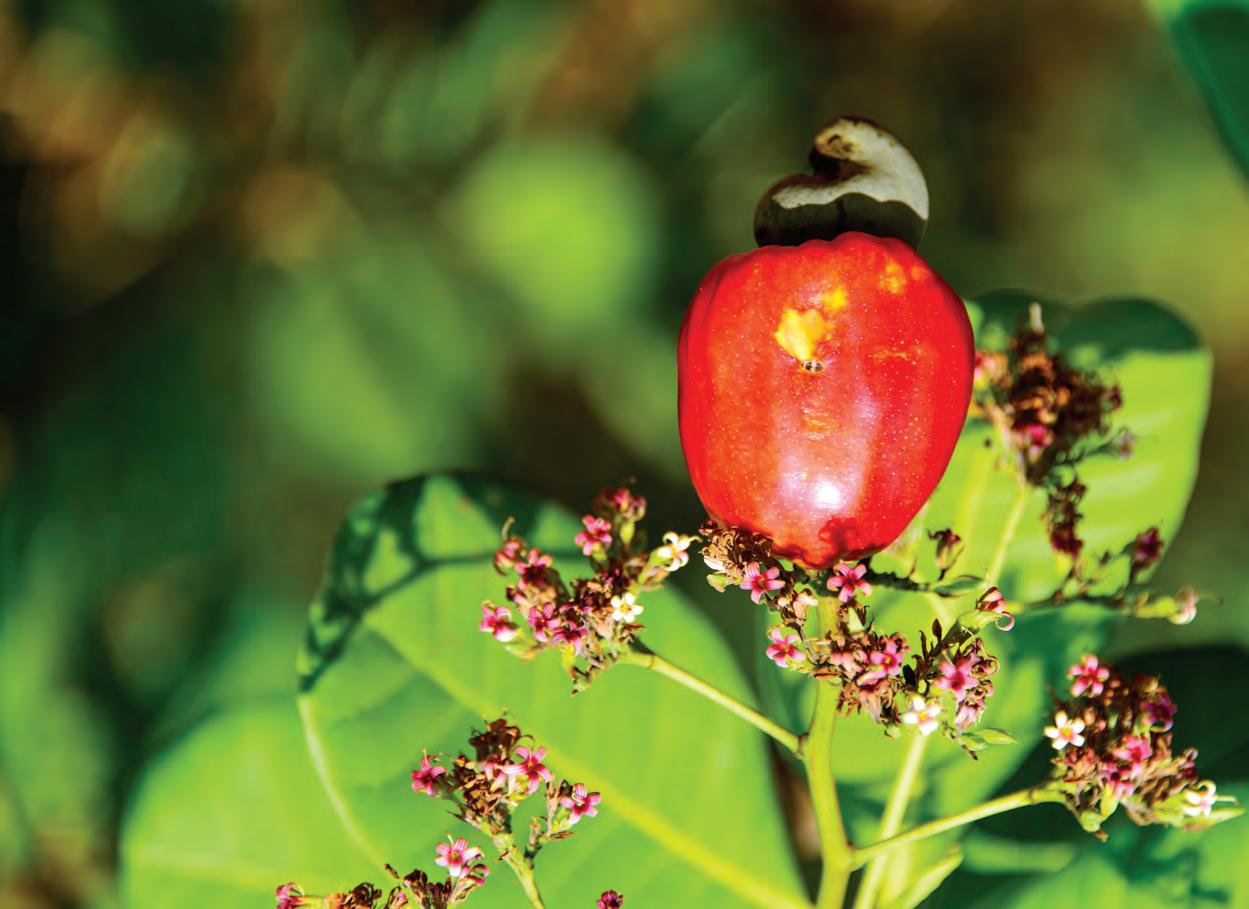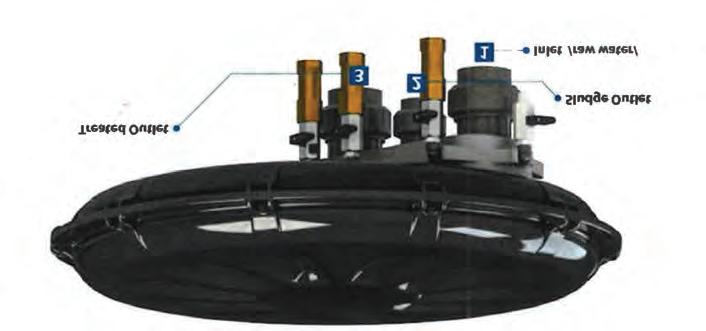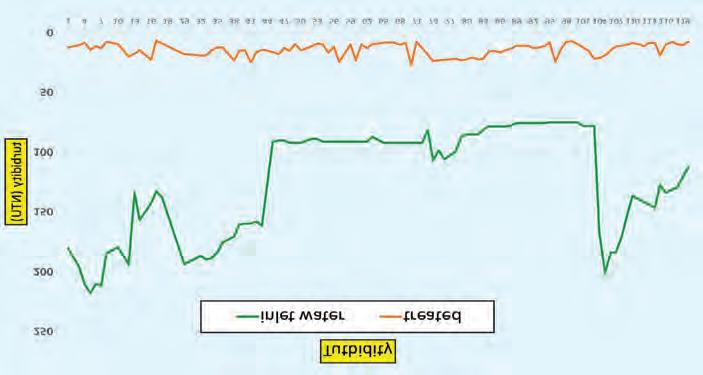
17 minute read
Crops
Despite many challenges, there are several initiatives contributing to improve production and value addition. Mwangi Mumero reports.
Cheer for the cashew sector in East Africa
Concerted efforts in Africa are helping to revive the cashew nut sector.
INCREASED GLOBAL DEMAND coupled with the need for a healthy lifestyle, has stimulated the revival of cashew nut production in Kenya as well as in neighbouring Tanzania.
Industry players, governments as well as donor organisations such as the European Union (EU) have also invested in the revival of local cashew nut production.
However, low prices and exploitation by intermediaries affect farmers.
“Farmers need a strong guarantee to move back to cashew nuts as many have switched to cotton, mangoes and coconuts ,” observed Joseph Mutuko, a farmer in Msambweni, Kwale County, near the Tanzanian border.
The global demand has increased by 53 per cent since 2010.
Research has established that cashew nuts have high levels of iron, magnesium, zinc, copper, phosphorus and manganese. They are also rich in mono-unsaturated fatty acids that promote healthy levels of good cholesterol.
“Local men believe cashew nuts boost virility as well as stomach discomfort. It is high in demand in Kenya,” observed Ali Hussein, a regular consumer of the nuts in the Kenya’s coastal town of Mombasa.
In Kenya, production currently stands at about 25,000 tonnes annually, far below the 1978 peak production of 38,000 tonnes. This production represents a meagre 0.6 per cent of the global production.
Yet, the industry still employs at least 68,950 farmers in the Kenyan coast.
A report by Kenya’s Nut and Oil Directorate noted that land under cashew nuts decreased from 28,758 hectares in 2015 to 21,284 the following year.
The production also went down from 18,907 to 11,404 tonnes in the same period.
Progress in Tanzania Tanzania on the other hand, has experienced a tremendous growth in the cashew nut sub-sector in the last few years.
For instance, the government projects a 33 per cent increase in production in the year ending September 2020: mainly due to favourable weather conditions and increased planting.
Output over the period is seen reaching 300,000 tonnes from 225,000 tonnes in the 2018-19 period.
In 2019, the government intervened and ordered a 94 per cent hike in farm gate prices to protect farmers from exploitation by middlemen of one of the country’s most valuable crop exports.
Sector revival in Kenya Efforts are currently underway in Kenya with the EU contributing US$2.4mn to boost the planting of new trees in Kilifi, Kwale and Lamu counties.
Through the Ten Senses Africa company, the EU is propagating cashew nut seedlings, providing extension services and buying nuts for processing on a factory to be established in three years in Kilifi County. “The seedlings are being procured by the county governments on behalf of farmers. A seedling costs KS 100 (US$1),” observed John Amatole, the company’s business development manager.
Launched in June 2018, the project has made remarkable progress, having distributed 450,000 high-yielding seedlings to farmers in Kwale, Kilifi and Lamu counties and obtained the fair trade certification of 15,000 smallholder farmers to enable them access high-value markets.
Ten Senses Africa in collaboration with Farm Africa, an international non-governmental organisation active in Kenya, is assisting in establishing three cashew seedling nurseries, training farmers on fair trade and organic certification and in providing incentives to youth and women to supply services to the value chain in a sustainable way.
Through a joint partnership with Slovakia, the Czech Republic, Poland and Hungary, the EU is funding the project to enhance livelihoods in the Kenyan coastal region by supporting organic and fair trade certification of smallholders.
This action is funded under the EU Emergency Trust Fund for Africa and is implemented by the Slovak Agency for International Development Co-operation along with V4 partner organisations which are actively engaged in training farmers - 45 per cent of them women, and promoting their products abroad.
Through the programme, young people and women are being trained in skills like pruning, controlling biological pests and diseases. Pruning has boosted production of existing trees, according to local farmers. “I have noted a considerable increase in production from pruned trees. So far, I have harvested 400 kgs of cashew nuts and sold to Ten Senses at Ksh75 (US$0.75) per kilogramme,” said Anna Jeremiah Nduku, a farmer in Kwale County.
The Government, through the Ministry of Agriculture, has subsidised the distribution of over 350,000 seedlings to various counties at the Coast in order to boost the supply of improved, grafted cashew nut seedlings.
The Kenya Agricultural and Livestock Research Organisation (KALRO) has also been active in reviving the crop and recently issued about 400,000 seedlings to farmers in the region.
“With new varieties of seedlings, we believe in a span of three years, the crop will be on its way for sustainable economic production,” observed Francis Muniu, KALRO’s head of horticulture and industrial crops research. Pruning has boosted production of existing trees, according to local farmers.
Local processors have decried low production among farmers even as global demand continues to rise.
“Our biggest markets are Europe and the US but our raw material is little. Local market is too small even as global prices continue to rise to over US$8 per kilo. Locally, a kilogram of cashew nuts is only US$1,” said Bobby Thomas, a director of Wondernuts Limited, a cashewnut processing firm based in Kilifi county.
Other firms dealing in cashew nuts in Kenya include Agro Group Limited which sells nuts at US$7000 per metric tonne and Wyzer Cashews. Chinese e-commerce giants Alibaba.com retails a small bag of Kenyan cashew nuts at US$1.20-2.50.
Among Tanzanian firms dealing with cashew nuts is the MeTL group .The company has one of the largest cashew nut processing facilities in the country.
Other companies include Tranax Investment Limited, Ruhuru Enterprises Company Limited and Connect India (Tz) Limited. On its part, Tanzania has also been seeking partners and investors to boost production and value addition.
The Tanzania Investment Centre (TIC), supported by the USAid, has drafted a strategy for cashew nut production and processing in four regions of Lindi, Mtwara, Tunduru and Pwani.
Investors are being sought for new plantations aimed at increasing production and total tonnage, suppliers of machinery, equipment and spare parts.
Other investors to put up industrial parks and cashew processing industries are also in demand in Tanzania, which accounts for 75 per cent of East Africa’s total production.
Investors in value addition to produce cashew nut butter, cheese, sweets, fruits drinks, lubricants, waterproofing and paints are equally in demand.
Across the African continent, production is expected to grow by 4.5 percent, according to Mordor Intelligence, a market research firm.
Côte d’Ivoire, Benin, Tanzania and Guinea Bissau are the largest producers.
Available data shows that in 2017-18, global cashew nut production stood at 3.9 million tonnes with Vietnam, India and Cote d’Ivoire leading the pack at 22 percent, 19 per cent and 18 per cent of the total world production, respectively. h
www.africanfarming.net Across the African continent, production is expected to grow by 4.5 percent, according to Mordor Intelligence.

Research by Global Market Insights, Inc. provides insights into the growth of the edible insects industry.
GLOBAL MARKET INSIGHTS, Inc., headquartered in Delaware, U.S., is a global market research and consulting service provider, offering syndicated and custom research reports for industries such as chemicals, advanced materials, technology, renewable energy and biotechnology.
In its edible insects market report the company, the company says that the global edible insects market is projected to achieve more than 47 per cent CAGR from 2020 to 2026, supported by rising consumer awareness about nutritional benefits of edible insects and willingness to explore new dietary trends.
A rapid shift of consumers towards high protein and low-calorie ingredients and rising competition to introduce innovative edible insect products is likely to boost the industry demand.
Industry players are utilising cricket and mealworm powders rich in protein and nine essential amino acids to prepare snack bars, energy and protein bars. Industry players are experimenting with various ingredients and flavours to make their product edible in raw form which is likely to encourage consumption. Rapid shift towards adopting high-quality protein powders in daily dietary needs is likely to boost edible insects industry growth.
Edible insects market set to cross US$1.5bn by 2026
Beetle and ant powders are widely used to fortify snacks such as potato chips, wedges, chocolates and other confectionery products. These powders contain a pure and high concentration of branched amino acids such as lysine and valine which aid in increasing immunity and muscle growth which should boost the outlook for the edible insects market. Edible insects are roasted, dried, and powdered to form high protein and lowcalorie flour. Most common edible insects available for consumption in market includes beetle, locusts, cricket, and ants.
Also, easy availability, protein extraction, high nutritional profile, and economic processing techniques is making edible insects popular among consumers which is likely to boost market demand.
Major findings of the edible insects market report include:
Changing dietary patterns towards low calorie and high protein sources owing to increasing consumer inclination to consume nutritious diets should propel the global industry trends.
Rising awareness on potential benefits of edible insects products and increasing
The report by Global Markets Insights, Inc points out that a rapid shift of consumers towards high protein and low-calorie ingredients and rising competition to introduce innovative edible insect products is likely to boost the industry demand.
Beetle and ant powders are widely used to fortify snacks such as potato chips, wedges, chocolates and other confectionery products.

demand for naturally fortified ingredients should boost market demand.
Major edible insects market players include Exo Protein, Gathr Foods, Crowbar Protein, Crik Nutrition, Cricket Flours, Crickers and Bugsolutely.
Companies are rapidly investing in R&D to capitalise on changing dietary needs and shift towards edible insect preparations.
Industry players are developing novel techniques to market their products by offering free samples, discounts, and attractive packaging.
Manufacturers are rapidly adopting new product development by introducing beta glucan-based food items such as bakery preparations, snacks and beverages.
Rapid adoption in the baking industry to include edible insects flours to prepare high quality and nutritious bread products to boost product demand.
Increasing prevalence of livestock diseases is making consumers opt for safe, economical, low calorie, and protein-rich alternative sources which are likely to boost the edible insect market share. h Image Credit: Adobe Stock
Technology is helping farmers gain better control over decisions in planting and paving the way for sustainable production. Enabling better planning for planting
PRECISION AGRICULTURE IS empowering farmers to plan in advance and optimise crop production. These are a few ways in which planning decisions for planting get impacted: Data for better planning - With the help of sensors, everything from air and water quality to soil and plant health are monitored at a greater accuracy level. Organisations such as the Global Open Data for Agriculture and Nutrition (GODAN) promotes the proactive sharing of open data to make information about agriculture and nutrition available, accessible and usable. Increased data availability and access to smart technologies empower farmers and companies, throughout the worldwide food production chain to better plan and execute food production and farming. Intelligent equipment - Automation in agriculture is now a necessity. Precision seeding equipment helps control the depth of seeds planted and the appropriate spacing. Equipment such as smart irrigation systems monitor moisture and temperature, aiding in watering and planting decisions. Drones - Drone technology makes a huge contribution to agriculture. Equipped with field-level imagery, they help complement precision farming techniques for agriculture. Artificial intelligence - The predictive power of artificial intelligence can help

Precision farming is empowering farmers to plan in advance.
farmers become more accurate in their planting and planning decisions. Weed control - Precise weed and pest maps serve as an input for modern largescale sprayers which are designed to spray with decimeter precision. This has an
impact on cost and the environment. In conclusion
Through efficient use of resources and emphasis on the benefits to the environment, precision farming offers sustainable ways of crop production.
Harnessing technology for optimising production to support everything from weed identification to crop health and yield estimation, precision agriculture relies on precise data to help feed the growing population. h

A case study on a farm in Kenya uses a novel solid separation process for increased efficiency in irrigation.
Water solutions for optimised irrigation
WITH TECHNOLOGIES HELPING farmers manage the use of resources, the need for better water quality at the inlet to the irrigation systems is gaining significance.
One of the main impurities that need to be removed to ensure the optimal functioning of irrigation systems are the particles that are present in the water. Particles might be present in the water from natural sources or from man-made pollution. While filtration might be a suitable solution for removing particles, a solid separation step will be needed either as pretreatment or a single process if turbidity levels exceed 50-100 Nephelometric Turbidity Unit (NTU) or for the treatment of fine particles, such as algae.
Traditionally, most solids separation processes that are being done are based on the density difference between the water and the particles. Particles might have higher density than water and will settle in a settling basin or will have lower density than water and will float and will be skimmed from the surface of the water. This results in either very large and expensive solutions, such as clarifiers, or costly and complex such as Dissolved Air Flotation.
AquaHD has developed the Natica, an innovative hydrodynamic separator that is a significant leap forward from conventional solid separation processes. Natica creates centripetal hydrodynamic forces to separate
An illustration of the separator.

particles under low pressure (1 bar). In Natica, water flows through a dedicated circular structure. The flow of the water in the circular structure allows the creation of high centrifugal forces (6-8 G) under low pressure. The unique geometry and flow patterns of the liquid inside Natica allows for the creation of laminar flow and for effective solids separation from the water stream. Due to the high centrifugal forces, particles will be concentrated in the outer perimeter of the separator. A specially designed outlet structure, will separate the stream rich in particles (near the outer perimeter) and the clean water stream. Particles that had been removed from the water will either go a further sludge thickening and dewatering treatment or will be sent back to the environment.
Turbidity

A graph showing the maintenance of water quality at the inlet to the irrigation system. Image Credit: AquaHD
Case Study: Water treatment for Kenyan farm The Golden Tulip company in Kenya, is a producer of vegetables, herbs and flowers in greenhouses. Water supply for the agricultural activities is from a nearby river. Water in the river is characterised by high turbidity (up to 500 NTU).
Aside from clogging the irrigation piping, the reaction between the particles in the water and the fertilisers had created sediments in the irrigation piping which required frequent replacements of all the irrigation system which resulted in high maintenance costs and long downtime in production.
Due to the light weight of the particles, sedimentation of the particles in a sedimentation pond had been proven ineffective even at very long residence time.
During the month of July 2019, the AquaHD team had completed a comprehensive demonstration project to test the ability of the Natica system to effectively treat the river water for particles removal and to maintain water quality at the inlet to the irrigation system at 20-30 NTU (over 95 per cent removal). As can been seen from the graph below, the system had exceeded the design requirement and continuously suppled water below 20 NTU.
Aside from the high efficiency of the system, the system is modular and thus additional separation units will be added in short period, based on the farm expansion plans. Installation of the system is very fast and it can be installed in as little as two weeks’ time. h
The Dangote fertiliser plant is helping to improve the ecosystem in Nigeria.
Dangote commences pre-testing of urea plant
DANGOTE FERTILISER LIMITED has started pre-testing of its US$2bn granulated urea fertiliser complex before inauguration urea complex plantThe current consumption of urea estimated at a dismal 700,000 tonnes per annum by Nigerian farmers.
The complex is located in the Dangote Free Zone. With a capacity of three million tonnes per annum, the plant has been classified as the biggest project in the entire fertiliser industry history in the world. Siapem of Italy is the engineering, procurement and supervision (EP) contractor for the project, while Tata Consulting Engineers (India) is the project management consultant (PMC) for the project.
At this time, several critical sections of the plant are going through various stages of pre-commissioning and test-run. Virtually all the sections of the plant such as Central Control Room, Ammonia and Urea Bulk Storage, Cooling Tower, Power Generator Plant, Granulation Plant, have all been completed and are going through pretesting.
Dangote Feritiser has started receiving gas supply from the Nigerian Gas Company and Chevron Nigeria Limited under the Gas Sale and Purchase was Agreement to supply 70 million scf per day of natural gas to Dangote Fertiliser Limited. The project, which will create thousands of direct and indirect jobs in construction and related fields, will provide a major boost to the agricultural sector by significantly reducing the importation of fertiliser in Nigeria and ultimately removing the need for imports when plant is in full production.
Devakumar Edwin, group executive director, strategy, portfolio development and capital projects, Dangote Industries Limited, said that Nigeria will be able to save US$500mn from import substitution and provide US$400mn from exports of products from the fertiliser plant.
He stated that the Dangote fertiliser project, which is estimated to gulp US$2bn, is the largest granulated Urea fertiliser
The goal is to reduce the importation of fertiliser in Nigeria.

complex to emerge in the entire fertiliser industry history in the world, with its three million tonnes per annum capacity.
“The current consumption of urea estimated at a dismal 700,000 tonnes per annum by Nigerian farmers is said to be due to very poor usage and is believed to be the cause of poor product yield, which threatens food security in the country.”
“By 2020, the Nigerian population is projected to increase to about 207mn which would lead to increased food production. Estimates points out that around five million tonnes of fertilisers are required per year in Nigeria in the next five to seven years bifurcated into 3.5mn tonnes of Urea and 1.5mn tonnes of NPK while current production levels in Nigeria are at 1.6mn tonnes by 2019.”
About Dangote Dangote fertilisers, is a component of the Dangote Group, one of Nigeria’s most diversified business conglomerates owned by businessman Aliko Dangote. The group products from cement, sugar, salt, food seasoning, vegetable oil, tomato paste, petrochemicals, package materials, logistics, real estate, food and beverages. The group is supporting the farmers in a large measure and have a team of trained agronomists as well as agricultural engineers, who go into the farms to help farmers.
Dangote is involved in seeds distribution, as well. Further, it is helping with soil testing, so the farmer is working with the right soil and fertiliser plant.
“With the potential of increased yields, the farmer will employ more hands. With increased yields and processing of the farm products, the employment potentials will be enormous,” said Devakumar Edwin.
He added that the focus of Dangote in agriculture is on how to grow the economy of teh country, not just in employment but in adding value.
Dangote Industriesb is active in strengthening the agribusiness environment across Nigeria. h






